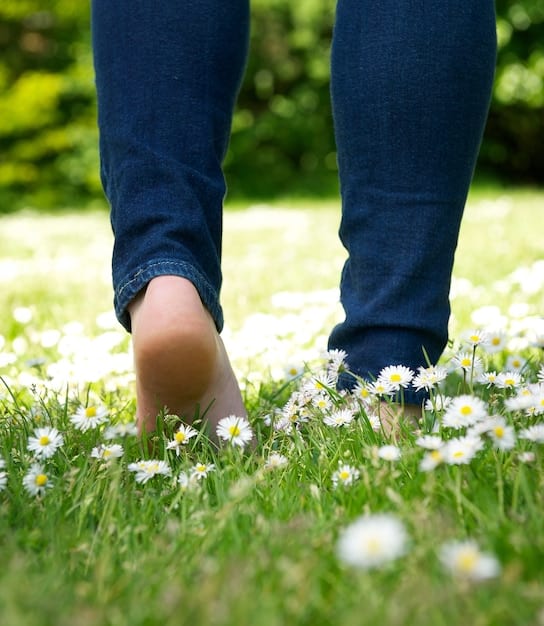Mindful Walking: Transform Your Walk into Meditation

Mindful walking transforms your daily stroll into a meditative experience by focusing on the present moment, enhancing well-being through heightened awareness of your body, breath, and surroundings.
Transform your daily walk into a serene and rejuvenating experience. Mindful walking: Transform your daily walk into a meditative experience for enhanced well-being involves bringing awareness to each step, breath, and sensation, turning a simple activity into a powerful practice for mental and physical health.
The Essence of Mindful Walking
Mindful walking is more than just a physical exercise; it’s a mental and emotional practice. It is an experience that involves paying attention to the present moment while walking, fully engaging your senses and thoughts.
By cultivating awareness, you can transform your walk into a moving meditation, reducing stress and improving your overall well-being.
What is Mindful Walking?
Mindful walking is a form of meditation that combines movement with mindful awareness. It involves focusing on the sensations of your body as you walk, such as the feeling of your feet making contact with the ground, the movement of your muscles, and the rhythm of your breath.
- Engage your senses: Pay attention to the sights, sounds, and smells around you.
- Focus on your breath: Coordinate your steps with your breath to create a steady rhythm.
- Acknowledge your thoughts: Notice any thoughts that arise without judgment, and gently redirect your attention back to your body and surroundings.
When practicing mindful walking, it is important to maintain a gentle and non-judgmental attitude. If your mind wanders, simply acknowledge the distraction and gently guide your attention back to the present moment.
Benefits of Mindful Walking
Incorporating mindful walking into your routine can bring a myriad of positive changes to your life. From reducing stress to enhancing creativity, the benefits are far-reaching.
Let’s explore the ways mindful walking can improve your physical, mental, and emotional well-being.

Physical Benefits
While walking is already a great physical activity, integrating mindfulness can amplify its benefits. Mindful walking encourages a deeper connection with your body, promoting better posture and movement.
- Improved cardiovascular health: Regular walking strengthens your heart and improves circulation.
- Increased energy levels: Mindful walking can help combat fatigue and boost your energy throughout the day.
- Enhanced balance and coordination: Focusing on each step can improve your balance and coordination, reducing the risk of falls.
By paying attention to your body while walking, you can also become more aware of any discomfort or tension, allowing you to address it before it becomes a bigger issue.
Mental and Emotional Benefits
Mindful walking has significant positive impacts on mental and emotional health. It can reduce stress, enhance focus, and promote a sense of calm.
By being present in the moment, you can quiet the mental chatter and find a sense of peace.
Mindful walking has significant positive impacts on mental and emotional health. It can reduce stress, enhance focus, and promote a sense of calm.
By being present in the moment, you can quiet the mental chatter and find a sense of peace.
Engaging in mindful walking can be a sanctuary. It can provide a respite from the burdens of daily life and allow you to appreciate your own well-being.
Setting the Stage for Mindful Walking
Before you embark on your mindful walking journey, it’s important to set the stage for success. Choosing the right environment and preparing your mind can significantly enhance your experience.
Let’s discuss where and how you can create the ideal setting for mindful walking.
Choosing the Right Environment
The environment in which you engage in mindful walking can greatly impact your experience. Opt for a place that is peaceful and free from distractions.
If you are at high risk of encountering significant distractions, it may still be useful to spend your time elsewhere.
However, there are still a good number of options for where you can walk mindfully:
- Nature trails: Walking in nature can heighten your senses and deepen your connection with the present moment.
- Quiet streets: If you live in an urban area, choose a quiet street with minimal traffic and noise.
- Parks: Parks offer a serene environment with greenery and open spaces.
Consider exploring local botanical gardens and scenic locations. You can experience new things while not being distracted.
Preparing Your Mind
Preparing your mind is as important as choosing the right environment. Before you start walking, take a few moments to center yourself and set your intention.
Doing this can help you get into a more productive and relaxed state.
Some preparation methods may include:
- Deep breathing: Take several deep breaths to calm your mind and relax your body.
- Setting an intention: Decide what you want to achieve during your walk, such as reducing stress or enhancing gratitude.
- Leaving technology behind: Disconnecting from technology can help you fully immerse yourself in the present moment.
By preparing your mind, you can create a more focused and intentional walking experience, maximizing the benefits of mindfulness.

Mindful Walking Techniques
While the concept of walking mindfully may be easy to understand, there is a right way to approach it. It becomes easier to perform with several techniques.
The two most important techniques are focusing on sensations of each step and coordinating your breath through walking.
Focusing on Sensations
One of the key techniques in mindful walking is focusing on the sensations of your body as you walk. Pay attention to the feeling of your feet making contact with the ground.
The feeling that each physical moment provides has a large amount of potential to make a large impact on you.
Focus on sensations like:
- Foot placement: Notice how your heel touches the ground first, followed by the ball of your foot and your toes.
- Muscle movement: Feel the muscles in your legs and feet contracting and relaxing with each step.
- Body posture: Be aware of your posture, keeping your back straight and your shoulders relaxed.
By focusing on these sensations, you can anchor yourself in the present moment and reduce mental distractions.
Coordinating Breath with Walking
Another effective technique is coordinating your breath with your steps. This helps to create a rhythmic and meditative experience.
When a steady rhythm is accomplished, it becomes easier for a person to engage in the meditative experience provided by walking.
Breath focus involves:
- Inhale: Inhale deeply through your nose for a set number of steps (e.g., four steps).
- Exhale: Exhale slowly through your mouth for the same number of steps.
- Repeat: Continue this pattern, adjusting the number of steps to suit your comfort and pace.
By coordinating your breath with your steps, you can deepen your focus and promote a sense of calm, allowing you to fully enjoy your mindful walking experience.
Overcoming Obstacles in Mindful Walking
As you begin your mindful walking practice, you may encounter some obstacles along the way. Distractions, restlessness, and discomfort can be common challenges.
Let’s explore how to overcome these hurdles and maintain a consistent and effective practice.
Dealing with Distractions
Distractions are inevitable in mindful walking. Whether it’s external noises or internal thoughts, something will always vie for your attention.
Considerations to explore are:
- Acknowledge and release: When you notice a distraction, acknowledge it without judgment and gently redirect your attention back to your breath or body sensations.
- Acceptance does not mean giving in: It merely means recognizing the distraction and refocusing accordingly.
- Choose quiet environments: Opt for quieter routes or times of day to minimize external distractions.
Every time you redirect your attention, you strengthen your ability to stay present and focused.
Handling Restlessness and Discomfort
Restlessness and physical discomfort can also hinder your mindful walking practice. If you feel restless, try adjusting your pace or changing your route.
It is important to listen to your body while engaging in mindful walking to ensure that it is safe and enjoyable.
Handling Restlessness and Discomfort consists of:
- Listen to your body: Pay attention to any signs of discomfort and adjust your pace or posture accordingly.
- Take breaks: If you feel overwhelmed, take a short break to stretch or rest before continuing.
- Be patient: It takes time to develop a consistent practice, so be kind to yourself and celebrate small victories.
By addressing these challenges with patience and understanding, you can create a sustainable and enjoyable mindful walking routine.
Integrating Mindful Walking into Your Daily Life
Integrating mindful walking into your daily life doesn’t require drastic changes. Small, consistent efforts can yield significant benefits over time.
Let’s explore how to incorporate this practice into your routine and make it a sustainable part of your lifestyle.
Finding Opportunities to Walk Mindfully
Look for opportunities to walk mindfully throughout your day. Instead of driving or taking public transportation, consider walking to nearby destinations.
Whenever you feel a need to become a more productive person, consider these suggestions:
- Commute: Walk to work or during your lunch break to incorporate mindfulness into your workday.
- Errands: Walk to the grocery store or post office instead of driving.
- Recreation: Take a mindful walk in your neighborhood or a local park for relaxation and exercise.
By actively seeking out opportunities to walk mindfully, you can transform mundane tasks into moments of peace and reflection.
Making It a Habit
To make mindful walking a habit, start small and gradually increase the duration and frequency of your walks. Consistency is key to experiencing the full benefits of this practice.
By taking small and sustainable steps, you can effectively establish mindful walking into your lifestyle.
Suggestions for consistency:
- Set a schedule: Designate specific times for your mindful walks and stick to them as much as possible.
- Find a walking buddy: Walking with a friend can provide motivation and accountability.
- Track your progress: Keep a journal or use a fitness app to monitor your walks and stay motivated.
By making mindful walking a regular part of your routine, you can cultivate a greater sense of well-being and presence in your daily life.
| Key Point | Brief Description |
|---|---|
| 🧘 Present Moment Focus | Engage senses to reduce stress. |
| 🚶 Body Awareness | Feel each step, improve coordination. |
| 🏞️ Environment Choice | Select quiet, natural settings. |
| ⏳ Habit Building | Schedule walks for consistency. |
Frequently Asked Questions
▼
Ideally, it should be 20-30 minutes so you feel the meditative effects. However, even a short 10-minute session can be beneficial if you are short on time.
▼
Yes, it can reduce anxiety by focusing your attention on the present, helping to calm your mind. It is a great stress-reliever.
▼
Yes, it’s natural. Simply acknowledge the thoughts without judgment and gently redirect your attention back to the present moment.
▼
It’s best to avoid music to fully engage your senses. However, if you must, opt for calm and instrumental music that doesn’t distract you.
▼
Aim for at least a few times a week to experience the benefits; daily practice can amplify the positive effects on your well-being over time.
Conclusion
Mindful walking: Transform your daily walk into a meditative experience for enhanced well-being offers a simple yet powerful way to enhance your mental and physical well-being. By focusing on the present moment, you can transform an ordinary activity into a moving meditation. Embrace this practice and experience the profound benefits it can bring to your life.





